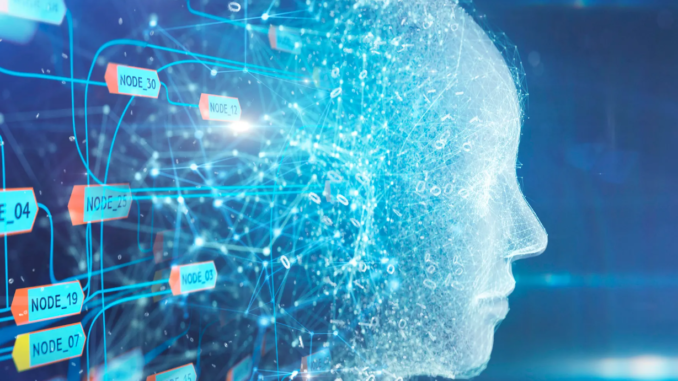
AI in the Classroom: Teachers & Students
There are many ways that AI can be used in the classroom for both teachers and students. However, as we incorporate AI in the classroom, we must be pro-active and conscious of how we implement AI. In the section below, I provide some items for teachers to consider when implementing AI in their classroom
- Provide your students with guidelines on how to use AI responsibly in the classroom. For example, encourage students to always try to complete their assignment independently and then use an AI tool to check or help edit their assignment. Introduce AI tools that will support their learning instead of replacing it. The video below gives some dos and donts of students using AI.
- Inform students that AI can be inaccurate and include bias on gender, race, location, social class, religion, and age. This can lead to misunderstandings, confusion, and unintentionally impact their worldviews.
- As you implement AI tools in the classroom, review the product of AI and then revise it if needed to make sure that it aligns with your teaching objectives.
- Be aware that all students may not have access to technology tools at home. Therefore, you may need to schedule time with specific students to provide them time to explore AI at school.
- Click the following link for AI tools that can be used in the classroom 30 AI Tools for the Classroom
Pros & Cons of AI in Schools
Pros:

- Personalized Learning Experiences & Resources
- Create Resources Quickly (Time Efficient)
- Gives Students & Teachers an Opportunity to Explore AI Tools for Real-Life Application
- Provide Teachers with Creative Ideas for Activities
- 24/7 Help for Students
- Prepare Students to use AI in the Future (Schooling, Jobs, Home)
Cons:

- Potential to Create Misunderstandings or Bias for Students
- May Lead to Students Relying on AI too Heavily
- Decrease in Deep Dives or In-Depth Discussions on Educational Content that Leads to Comprehension
- Human Error can be Intentionally or Unintentionally Present in AI
- Lack of Accessibility to AI for Students at Home and/or School
Awareness of AI Bias
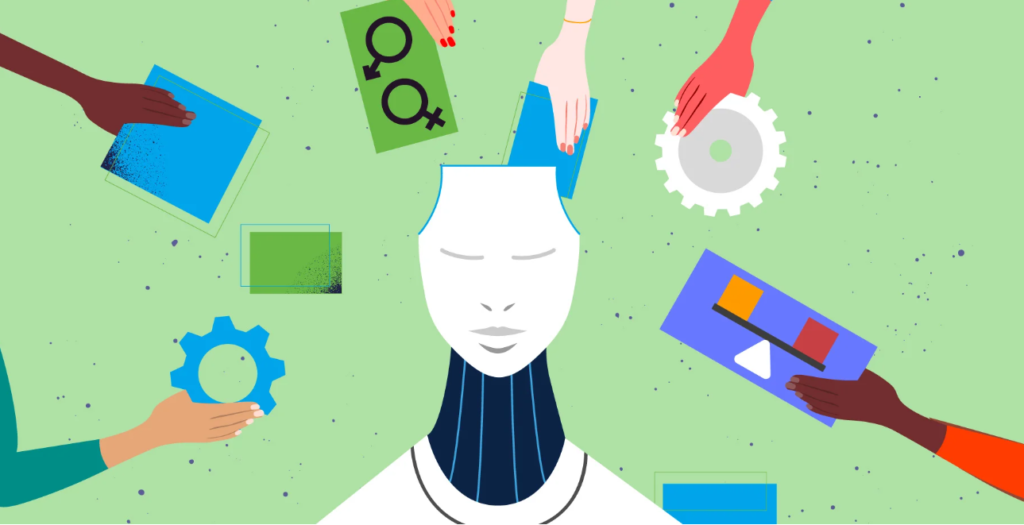
What is AI Bias? Where does it come from?
AI bias occurs when an algorithm produces results that are systemically prejudiced due to wrongfully made assumptions in the machine learning. Biases also appear because of the individuals who design the algorithms, reflect unintended cognitive biases or real-life prejudices. Another reason an AI system includes bias results is due to the usage of incomplete, fault or prejudicial data sets that reflect the machine learning systems. These biases can lead to misunderstandings and inaccurate information that can affect both teacher and student learning. Check out this blog on AI bias, AI in Education: The Bias Dilemma.
Types of AI Bias from Machine Learning Bias (Gillis, 2023)
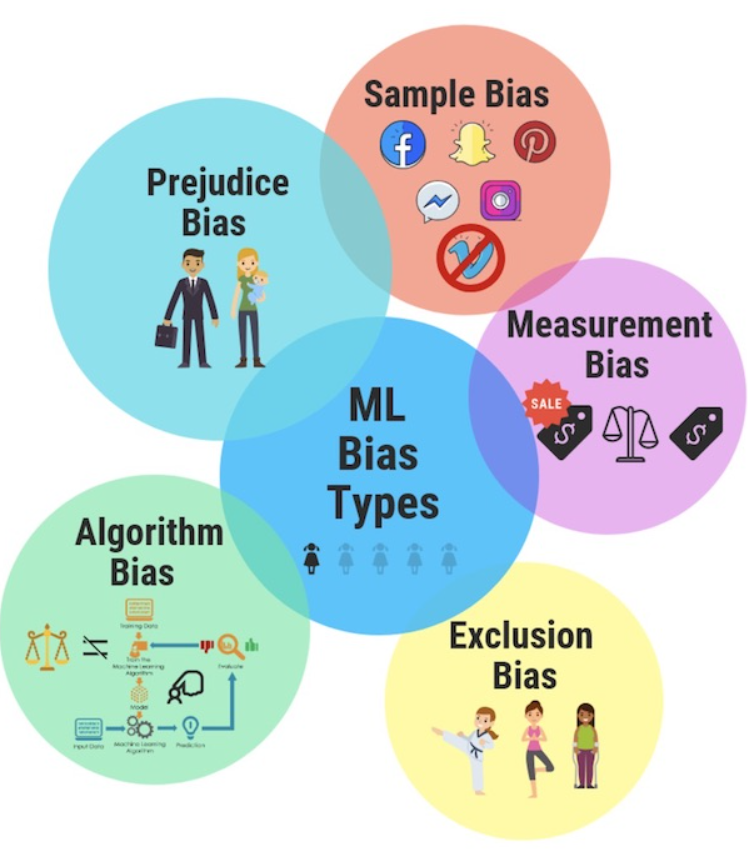
- Algorithm Bias: A problem that occurs within the algorithm that conducts the calculations that power the AI computation and learning process.
- Sample Bias: This bias appears when the AI learning system doesn’t have a large data collection/bank or an accurate amount of representative data. For example, data that includes only one gender.
- Prejudice Bias: The data used to train the AI reflects existing prejudices, stereotypes and faulty societal assumptions. By including this, the system reflects those biases into the machine learning system.
- Measurement Bias: This bias occurs when there are underlying problems with the accuracy of the data and how it was measures or assessed.
- Exclusion Bias: This forms when an essential data point is left out of the data being used to train the AI system. This occurs when the modelers don’t recognize the data point as consequential.
- Selection Bias: When the data used in training AI isn’t large enough or representative enough, can lead to misrepresenting and lowering accuracy for both results and performance.
- Recall Bias: This bias develops in the data labeling state, where labels are inconsistently given through subjective observations.
Rectify AI Bias As I Implement AI Tools
As educators, it is our responsibility to prepare students to be lifelong learners and provide them with the tools to be successful after school. Whether we like it or not AI is apart of this world. It is now part of our job to explore AI in order to help our students understand the benefits and consequence of using AI. Here are some ways I will rectify AI in my classroom.
- Review & Evaluate Products: A major way that we can rectify AI bias, is to be aware that AI tools will sometimes produce bias materials. Therefore, we must always review and evaluate the products that AI produces and then decide if this will help or hurt our students’ learning.
- Create Guidelines and Show How to Use AI Responsibly: Even though AI is new, we must try to develop guidelines for our students on how to use AI responsibly. This includes showing students how to use AI by providing the dos, donts, and cautions of AI products. Showing and modeling how to use AI responsibly, will be crucial for teaching my students how to use AI for educational purposes.
- Awareness that AI can be Potentially Harmful: Make sure students are aware of the AI bias and misunderstandings that can occur when using AI tools. In order for my students to understand the benefits of AI, they must be aware of the harm it may cause to them. Students must be conscious to not take all AI products for the truth. They need to consider that there will be bias and misconceptions that arise when using AI tools. It is their job to be able to identify these because it can alter their worldviews without them even noticing. Awareness of AI is crucial to using it responsibly.
- Start Small: AI is becoming the trend in education. However, for those who are not comfortable with incorporating AI in the classroom, start small. Before implementing AI, conduct some exploration of AI tools and do research on each AI tool you find. It’s not about how many AI tools you can find, it’s about finding the AI tools that will benefit your teaching practices to increase your students’ learning.
AI Implementation in Kindergarten
I am still new at incorporating AI into my classroom and trying to figure out how to teach AI to my Kindergarteners will be a lot of trial and error. I think the number one thing I will have to consider is what to introduce to them. We usually do not introduce our computers until the 2nd quarter and the first thing we teach them is how to use the keyboard, pad, screen, login, and passwords. Once we teach the fundamentals, I think explore AI tools together on a class computer and figuring out what the students find interesting will be key to decide on what to implement. Teaching AI in Kindergarten, is a blog that discusses how AI can be introduced to Kindergarteners. I found it interesting how AI ethical topics can be brought up during play time.
AI Tool: Text Dependent Question Generator
This week I decided to implement the text dependent question generator from the Magic School website. Our class worked with the text, Rap a Tap Tap: Here’s Bojangles Think About That. Throughout the week, we discussed the rhythm of the text, the author’s purpose, and reviewed the senses that we use during the read-aloud. To support the text, we watched several of Bojangles dancing videos and discussed his background. I used the text dependent generator to create 5 text dependent questions I used on Thursday for our whole group discussion. The AI generated questions are below:
- What is the main theme of the book?
- How does Bojangles make an impact in the story?
- What is the significance of the phrase “Rap a Tap Tap” in the title?
- How does the author use rhythm and language to engage the reader?
- What emotions does the author evoke through the text?
Successful Implementation of AI
The questions generated by AI, created an engaging discussion for my class and these questions were not included in our curriculum. I was curious to see how my students would answer Questions 3 & 4 because they would have to relate that rap a tap tap was the rhythm and that it represented Bojangles tap dancing throughout the story. My students exceeding my expectations and were able to identify the significance of “rap a tap tap” and even during the story would act out tap dancing like Bojangles. I had several students tell me the reason that they felt engaged in the story was because “I feel like I can hear the tapping and I like to act out parts of the story by tap dancing.” For Question 5, I decided to do a discussion first and had students go back to draw a picture of at least one emotion that the author was able to make them feel. The majority of students drew happy faces of the people listening to Bojangles dancing through the story. I did have two students draw some sad faces and when I asked them what made them sad in the story, they told me that some of the doors were closed on Bojangles because “he had a different skin color than them, but it still makes me happy that so many other people liked him and didn’t care about his color,.” Students were able to make this connection because of the background that we provided on Bojangles and the conflict that was occurring during this time period. It was a deep conversation and it was fascinating to see how even Kindergarteners were able to sense that emotion and conflict from the story and videos.
Challenges & Next Time:
For this AI tool, I did not face any challenges because they were questions that made sense and related well with my read-aloud. When I use this tool next time, I was thinking that I would use it in front of my students to show them how to use AI to develop questions. For our next read aloud, I will pull up the tool and type in the text. We will use our Wonder Wheel and Question Corners to sort the questions that the AI develops and decide if they are any questions that we want to keep and explore more. It is important to remember that AI doesn’t have to replace our teaching practices. We can use AI tools to enhance and better our current teaching practices.
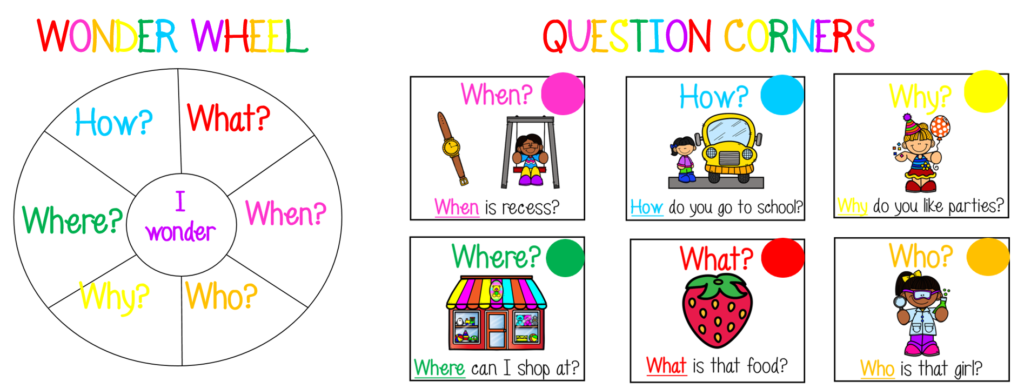
TCE Thresholds Concepts Connected to AI
Threshold Concept #1: Teaching is/as Intellectual Engagement
- Some educators are very skeptical about using AI in their teaching, whether it’s allowing students to use AI in the classroom or creating teaching materials that may not be traditional. Honestly, at first I was too because I was unaware of the benefits that AI can bring to my teaching. However, there are benefits to using AI in our teaching because AI can provide suggestions, but we still have the power to change or revise what materials AI produces. We need to make sure that we don’t just use what AI uses because it is quick and easy. As educators we need to evaluate the materials AI creates to ensure that it supports our learners’ needs and if revision needs to occur, we can provide the suggestions to AI until we are happy with the final product. Intellectual engagement can happen between teachers, students, and now AI. We have to be willing to open up to the concept of AI because it is not leaving the education field and most likely will become even more apparent in the future.
- In order to prepare to teach about AI, I need to make sure that I understand the AI tools I introduce to my students. I need to be prepared to teach students both the benefits and consequences of AI and the bias that AI can have.
- Check out this blog that shows how AI is revolutionizing teaching and shows how AI is engaging. AI Tools Revolutionizing Education
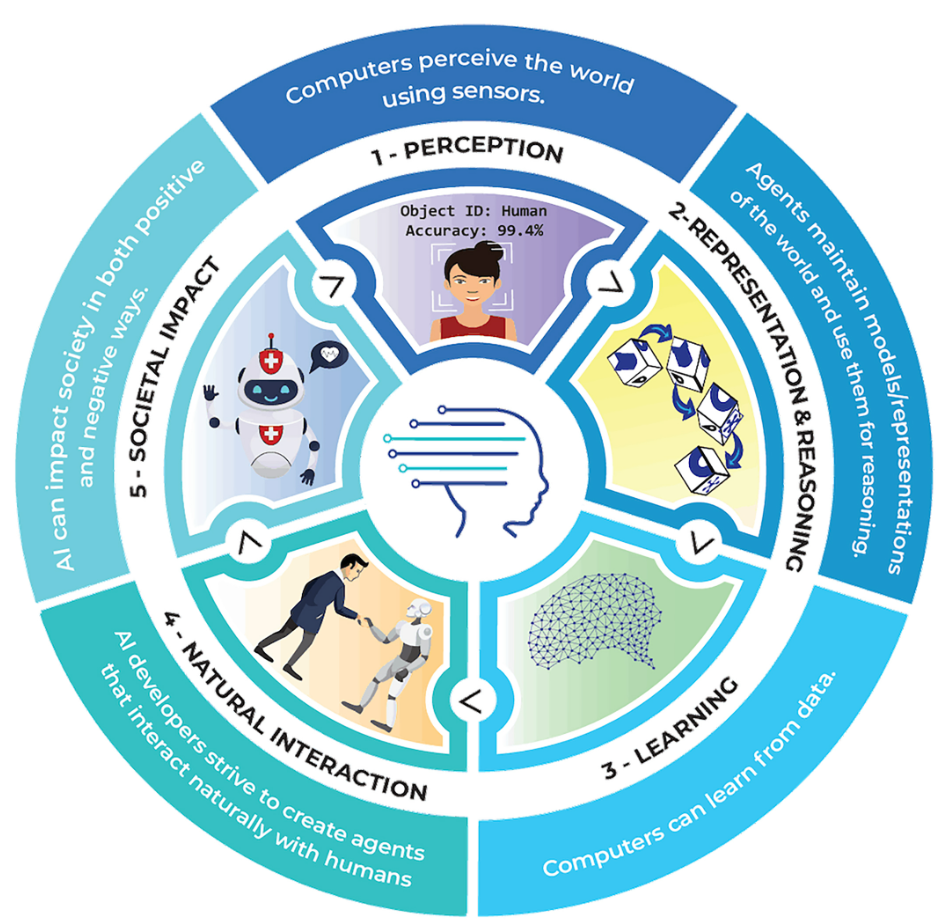
Threshold Concept #2: Curriculum is Co-Constructed
- Currently there are AI tools that can be used to help educators develop lesson plans, units, and activities that can be implemented in the classroom. Therefore, AI can co-construct our teachings and curriculum. Even though there are tools to help us co-construct our teachings, we still need to evaluate and revise these tools before implementation.
- As AI develops, both teachers and students will be learning about AI together. While AI evolves, teachers and students will be learning how to use these tools in the classroom. Also, guidelines will need to be constructed to make sure that AI is used responsibly. The best way to do this is through trial and error, modeling, and sharing both teacher and student experiences with AI.
- Check out this blog, Designing For The Future With AI: Lessons Learned In Curriculum Development.

Hi Brittany! I loved reading your blog post! I can connect to you coming from an Early Childhood background myself. As a third-grade teacher, I also am not sure how to have students use AI in my classroom yet. I appreciate you explaining the timeline of how kindergarten students learn their computer skills because I have never taught kindergarten so it was super helpful to understand. Hats off to you, it is quite amazing how you teach them all of those computer basics. I also used Magic School AI and can relate with you in that it develops understandable and easy-to-use questions. I had it make math word problems and it worked out well. You gave me a great idea to show students how AI can generate questions. I think our students will be amazed! I am definitely going to try this.
I completely agree that AI can enhance our current classroom instruction. I don’t plan on having it take over my lesson plans and worksheets, but I can certainly use it to help me generate some ideas and save some time! I appreciate you linking to the blog post about AI Biases. It was hard for me to think of a long list and the information you presented was so easy to understand! Great post!
Hi Brittany!
I loved reading about your experience with Magic School. That sounds like a great tool for early childhood, which I would love to implement in my lessons. I like how it came up with questions that were different than what was included in the curriculum. Does this website include the text too or just the questions? It sounds like it was an engaging lesson for your kindergarteners!
Hi Brittany!
I thoroughly enjoyed reading your blog post. You have such awesome graphics and ideas that really stuck out and made me want to continue reading. I have learned a lot about AI in these past two weeks, and I think one of the more vivid realizations I have had is that like all technology, it’s (AI) going to have its flaws. Quite frankly, any piece of technology that may be deemed as “perfect” might cause even more concern. As we’ve dived into AI’s pros, cons, biases, and more, I’ve come to understand that these tools are only as good as those who create them. Anyone clever and creative enough to come up with such resources knows that it’s always going to have its inevitable quirks and imperfections, however, the very inequities we already know exist in education should be what these new technologies are addressing and deconstructing, not creating more of. We have discussed how AI doesn’t have the ability to be personal, show empathy, or build relationships, but it can create lesson plans, grade papers, and offer immediate feedback to students. Because of the balance of good and bad AI bestows, we must balance its use in our classrooms and make sure that we aren’t giving AI too much power, taking away from the epitome of an educator’s role.
We already see so much of AI in our education now and whether we like it or not, it’s here to stay. The even crazier part is that some of us use AI tools and didn’t even know they were AI functions. As teachers, we have to amplify our awareness and be more in tune as to what we’re doing and how we’re regulating technology use in our classrooms. We want to prevent our students from over relying on AI but also show them that there are multiple avenues to learning, they just have to be used wisely.
Thanks for sharing your ideas (: